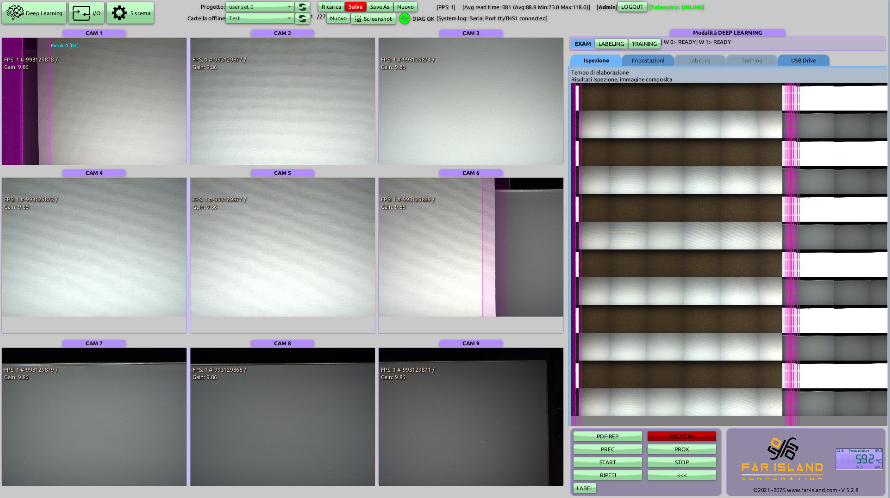Case Study — Inspection of Painting Canvases with Ai1 and Medusa
Application Context
A company specialized in the production of painting canvases for the fine arts sector implemented an automated computer vision-based quality inspection system to ensure the absence of surface and structural defects before packaging.
Objectives
- Detect surface defects using reflective lighting and internal imperfections using transmission lighting.
- Automate the quality control process to increase efficiency and reduce waste.
- Classify defects by type and location, enabling corrective actions or automatic rejection.
Technical Solution
The system is based on a customized Ai1 module running proprietary Medusa software, equipped with 9 area-scan cameras (3.2 MPixel) and a dual lighting system for both reflection and transmission.
- 9 synchronized area-scan cameras (3.2 MPixel each)
- Dual LED lighting:
- Top (reflection) to detect visible defects such as smears, folds, and contamination
- Bottom (transmission) to detect holes, broken fibers, and internal stains
- Real-time processing using Ai1 and Medusa on edge hardware
- Image acquisition synchronized with linear encoder and trigger signals
Defects Detected
- Micro-holes not visible to the naked eye (detected via transmission)
- Ink smears, halos, and contamination
- Longitudinal and transversal folds
- Broken fibers or irregular textile density
Example from Medusa Software
Below is a real screenshot of the Medusa software inspecting a painting canvas:

Learning and Adaptability
The system is designed to evolve alongside production:
- The customer can autonomously update the AI model as new defect types are discovered.
- Each labeled defect is included in incremental training, improving recognition accuracy over time.
Thanks to the flexibility of Medusa:
- Users can define custom inspection profiles based on geometric characteristics of defects (width, height, area).
- It is possible to create quality filters for different acceptance levels, from museum-grade to industrial tolerance.
Results
| Indicator | Before | After Ai1 + Medusa |
| Manually rejected products | 6.8% | 0.9% |
| Average inspection time (manual) | ~18 sec | < 3 sec |
| Undetected defects | Not tracked | < 0.5% |
Line Integration
- Digital output for conveyor stop in case of critical defect
- Automatic image logging for defect traceability
- User-friendly interface for profile and recipe management
Flexibility
The system is designed to handle various canvas formats with minimal hardware modifications. Thanks to Medusa:
- Users can configure quality thresholds and inspection profiles independently
- The AI adapts automatically to different weaves, thicknesses, and transparency levels
